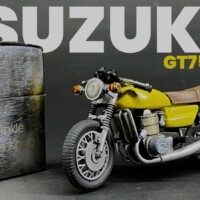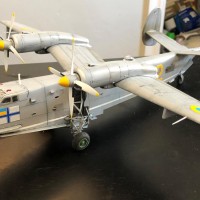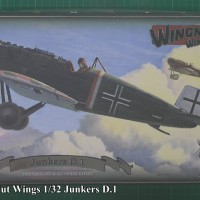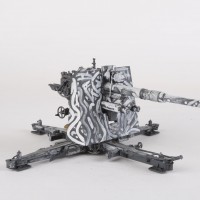Invasion Stripes: Airspeed AS.51 Horsa, Bronco Models 1/35 – 'Churchill's Reply', Operation Mallard, Normandy 1944.
Historically Hengist and Horsa were Germanic brothers said to have led the Angles, Saxons and Jutes in their supposed invasion of Britain in the 5th century. In 1944 the ‘first boots on the ground' on D-Day at 00:11 were carried by Airspeed Horsa Gliders, deploying Airborne troops inland to support the beaches and attack the bridgehead.
When we decided to put together a mini group build commemorating ‘invasion stripes' my stash was reasonably empty of D-Day planes, except for a Tamiya Mustang. The choice I made at that point, was questionable, since I'd seen the Bronco 1/35 Horsa given dreadful reviews and since it was massive. Now it is built, it is so ridiculously huge that I'm not sure where it is going. If you have seen the film ‘Close Encounters of The Third Kind you'll understand why I began to feel like I was building a ‘mountain of mud'. The glider was ‘a presence' and my family were definitely giving me those ‘funny looks' reserved for those who dabble in the plastic!
Despite watching Youtube and seeing a highly competent Irish modeller descend into invective and alcohol in the face of this kit I was growing ever more convinced it was the way to go.
Codenamed Operation Mallard the airborne action conducted by the British army on D-Day, June 6th 1944, complemented the Normandy Landings. It was an operation designed to support the 6th Airborne division on the left flank of the British invasion beaches, using two landing zones near the Caen canal and the River Orne.
The various glider operations that day, were increased by Mallard which contributes 256 gliders, towed by a variety of heavy aircraft. This meant glider-bourne troops began landing in Normandy just after midnight and continued in waves throughout the day, to just beyond 9pm which was still a daylight hour in the European summer; 246 landed safely.
The kit started well. The cockpit and nose section went together uneventfully and replicated quite accurately the very basic controls used by the brave men of the British Army's Glider Regiment, two per glider, including the gas bottles used to deploy the air brakes. Once their aircraft had completed its one way trip the pilots simply bade it farewell joined the fight.
The 'dreaded' central section of the glider had also started hopeully and the wooden flooring and airframe were also going together 'fairly well'.
So as the group chatted I was gradually becoming convinced to complicate things by adding elements and making a vignette. I looked at a few pictures, read a few books, listened to podcasts and began to start thinking what it might all eventually look like. It seemed logical after a while that I would need a 1/4 ton truck and trailer and some figures.
To my great excitement Bronco made exactly that combination in a single box, and the Airborne truck and trailer were soon headed my way.
When it arrived I realised just how much work I had signed up for, it has hundreds of parts requires wires to be added as part of the steering, has a plethora of photo-etch and contains 8 figures. I went back to Youtube to relearn about figure painting and how to make a large base, which oddly enough had the affect of encouraging me to study the effect of tyres on slightly wet grass.
It was when I started to plaster the polystyrene sheet that was to be used as a base that I realised the whole project was getting out of hand. I had just purchased a 'static grass' kit and was eyeing up a dry stone wall. I now needed 2 more containers of plaster. It had turned out that the exact glider I had decided to build, which transported the Royal Ulster Rifles into France, had crashed into a dry stone wall, behind which there were some trees. There were some great archive pictures from the Imperial War Museum of the crash.
The truck and trailer were going well but taking a long time.
I had a small dry stone wall to paint. The figures were looking half human.
I had some 'filigree' trees. The base was taking shape.
The large troop-carrying Horsa glider was capable of transporting a maximum of 30 seated fully equipped troops; it also had the flexibility to carry a Jeep and trailer or an Ordnance QF 6-pounder anti-tank gun. The Horsa Mark I had a wingspan of 88 feet (27 m) and a length of 67 feet (20 m), and when fully loaded weighed 15,250 lb (6,920 kg). The Horsa was constructed largely of wood.
The fuselage joint at the rear end of the main section could be disconnected upon landing to facilitate the rapid unloading of troops and equipment, for which metal ramps were employed. The tails were often removed by detonating a ring of explosives around the rear fuselage. But this was hazardous if enemy fire hit the tail joint. In early 1944, a method of detaching the tail was devised that used eight quick-release bolts, and wire-cutters to sever the control cables. Either way, upon seeing aerial pictures of the landing zone near Ranville, where the glider made their landings, and where many sat, having served their purpose with no tails, I decided the tail would be 'off' in the vignette for a number of reasons. Avoiding another joint that looked entirely likely to fail without filler and force was a good option. Changing the shape of what is essential a flying tube was better aesthetically and it terms of space. The option to show a little more interior once the models were completed also appealed, so I built, painted and 'decaled' the tail as a stand-alone element. At one point I thought it may represent the whole of the glider!
The truck and trailer were going well too and I couldn't resist putting the vehicles inside the framework of the glider.
Later on D-Day, as the battle raged around Caen canal and the River Orne, Operation Mallard went into effect with gliders escorted by Allied fighters. They landed at approximately 2100.
The gliders touched down at two landing areas, Landing Zone 'W' (LZW) to the east of Saint-Aubin-d'Arquenay and Landing Zone 'N' (LZN) to the north of Ranville, where "Churchill's Reply" hit the dry stone wall, but was relatively unscathed. Moving off LZN the 1st Battalion, Royal Ulster Rifles headed south to capture the villages of Longueval and Sainte-Honorine-de-Chardronnette. It is that moment I tried to capture in my vignette.
The 211th Battery, 53rd (Worcester Yeomanry) Airlanding Light Regiment, Royal Artillery also arrived at LZN equipped with eight 75 mm Pack Howitzers and were pounding German targets within half an hour of touching down. The 2nd Battalion, Oxfordshire and Buckinghamshire Light Infantry, furthest away at LZW, crossed the Caen canal and River Orne bridges. These had been captured twenty-one hours earlier by their own 'D' Company who were now headed towards Herouvillette and Escoville.By midnight, the 6th Airborne Division was the only Allied formation to have seized all of its D-Day objectives.
With the wing built and painted, and decals on, it was time to face the inevitable. It is a nice kit until the point at which the side and top panels go on.
The fit in these areas in my copy of the model was awful, regardless of whether the parts were warped, a problem I had to fix with warm water and careful massaging. This was the only way I could convince the thing to get into positions where the mating surfaces actually got anywhere they needed to be. With clamps and force (usually a bad idea) it all stuck together with superglue and filler. Even then there were serious gaps.
The Airpeed Horsa was made by expert furniture makers, initially by one firm in the East End of London. It was a wonder of engineering made in the same factories and from the same materials as the Mosquito. Those craftsmen would shudder to see the joints on my kit! One saving grace is that the joints are at the boundaries between the black night camouflage and the green and earth standard paint scheme.
Having made it through the traumatic 5 or 6 hours of getting the central section together the joy returned. I had convinced myself that any steep landing, heavy glider, laden with armour or vehicles would look the worse for wear after its one and only flight (notably the practice aircraft during training, landed and took off a large number of times to avoid waste). The base had been coated in white glue and static grass applied. Trees, some clumps of longer grass and the wall were positioned, and I made tyre trials. The undercart, skid and wheels are really well made to support such a large model. It is tragic that the central section is so hit-and-miss.
My wife and two boys saw our house deteriorate as this vignette came into shape on a table inside, rather than in my workshop. I'd run out of space! They were all very happy to see the vignette as they got up this morning, after I'd had another late night building and finishing off just in time for D-Day.
The kit was a lot of fun for 95% of the build. The learning and camaraderie during this project has been fantastic. To Chuck, Louis and Gary my admiration and esteem. To Tom, my thoughts and wishes for gradually better times.
And I still don't know what I'm going to do with this vignette!




































Paul Barber (@yellow10)
It was an absolute joy and wonderful learning experience to watch this one come together. I know you were worried about getting this done in time... but like the 6th Airborne Division you met your objectives.
What really struck a nerve with me this morning was when one of us made a comment just prior to our scheduled joint postings. The one about what it must have been like for the men circling around in their landing craft waiting for the exact moment to go. I would take our kind of waiting any day...
Never forget.
You hit a huge home run here ! I believe it's your best one yet.
That’s too kind,Louis. This one fought me for a while. Glad to get out of it with a finished piece.
A very cool project, and expertly executed! Well done!
Thanks again, Gregg!
Simply an amazing and incredible endeavour Paul. And with in the time frame in completing it on time. I was able to finish 2 of 3, the ICM B-26 arrived too late to even get started on it. Projects like this when you are quite satisfying. Well done in planning, assembly and fixing the issues. Thanks for sharing.
Thanks so much, Chuck.
That’s an impressive model, Paul. Well done!
It’s pretty big Jihn, I got the HK models 1/48 Lanc this week. It is was smaller. Even the Felixstowe looks do-able now.
What a wonderful model, Paul!
Congratulations!
Cheers, Spiros.
This is a wonderful diorama and ditto glider, Paul @yellow10
I was surprised by the size of these gliders when seeing a 1:1 in a nearby museum.
Amazing they built so many for the one way trip. Very effect none-the-less.
Thanks, John!
This all came together very nicely, Paul. So fun to watch this beast grow! Well done!
Cheers, Gary. Great fun spending time with the group!